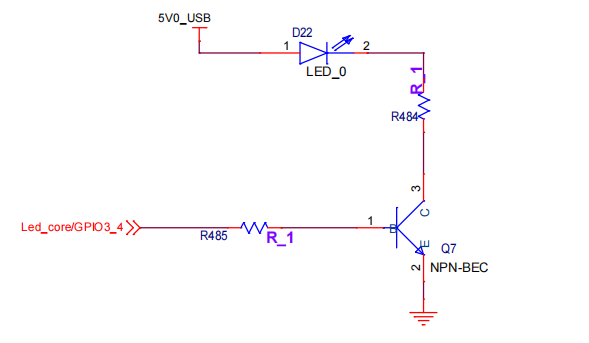

OpenHarmony3.0上编译C控制Hi3516开发板的LED闪烁
描述
OpenHarmony 分为轻量系统、小型系统、标准系统,目前对应 LiteOS-M、LiteOS-A、Linux 内核。但好像并没有说一定是按照使用内核来划分。我们这里姑且先这么区分。
本文使用的是比较新的 OpenHarmony 3.0 LTS 版本,Linux 内核,编译标准系统。
官方文档已经说明了,如何使用 DevEco Studio 开发 hap 包,并运行在开发板,但是 ACE 框架能力有限。
设备硬件开发还是需要 C,所以这篇文章,将在标准系统下编译 C 控制 Hi3516 开发板的 LED 闪烁。
环境准备
3.0 源码下载:
repo init -u https://gitee.com/openharmony/manifest.git -b OpenHarmony-3.0-LTS --no-repo-verify
repo sync -c
repo forall -c ‘git lfs pull’
区别于 2.0 需要安装 ruby,其他基本都一样。
sudo apt-get install ruby-full
编译命令:
build/prebuilts_download.sh
。/build.sh --product-name Hi3516DV300
编写 helloworld.c
在 applicationsstandard 目录下新建一个 app 目录来存放 .c 的业务代码。
比如 applicationsstandardapphelloworld.c 内容容下:
#include 《stdio.h》int main(){
printf(“Hello world.
”);
return 0;
}
然后在当前目录新建编译脚本 BUILD.gn 内容如下:
import(“//build/ohos.gni”)
import(“//drivers/adapter/uhdf2/uhdf.gni”)
ohos_executable(“helloworld”) {
sources = [
“helloworld.c”
]
subsystem_name = “applications”
part_name = “prebuilt_hap”
}
然后添加到编译框架 applicationsstandardhapohos.build 增加如下内容。
“//applications/standard/app:helloworld”
最后执行编译命令即可,开发板使用的是 Hi3516,在不指定 out 目录时,缺省生成在 /system/lib64 或 /system/lib 下。

点亮开发板 LED
能打印 helloworld 说明环境是没问题的,接下来尝试点亮开发板的 LED。查看 Hi3516DV300 原理图:


Hi3516DV300 共有 4 层板,由原理图可知:最上层板的红外补光灯接在 GPIO5_1,绿色 LED 指示灯在 GPIO2_3,核心板的红色 LED 在 GPIO3_4。
接下来参考 OpenHarmony GPIO 驱动说明:
https://gitee.com/openharmony/docs/blob/master/zh-cn/device-dev/driver/driver-platform-gpio-des.md
确定GPIO管脚号:不同SOC芯片由于其GPIO控制器型号、参数、以及控制器驱动的不同,GPIO管脚号的换算方式不一样。
①Hi3516DV300:控制器管理 12 组 GPIO 管脚,每组 8 个。
GPIO 号 = GPIO 组索引 (0~11) * 每组 GPIO 管脚数(8) + 组内偏移
举例:GPIO10_3 的 GPIO 号 = 10 * 8 + 3 = 83。
②Hi3518EV300:控制器管理 10 组 GPIO 管脚,每组 10 个。
GPIO 号 = GPIO 组索引 (0~9) * 每组 GPIO 管脚数(10) + 组内偏移
举例:GPIO7_3 的 GPIO 管脚号 = 7 * 10 + 3 = 73
由此可以得出:
GPIO5_1 = 5 * 8 + 1;
GPIO2_3 = 2 * 8 + 3;
GPIO3_4 = 3 * 8 + 4;
然后新建 applicationsstandardappledtest.c,内容如下:
#include 《stdlib.h》 // standard library 标准库函数头文件#include 《stdio.h》 // standard input output 标准输入输出函数#include 《stdint.h》 // 定义了扩展的整数类型和宏#include 《unistd.h》 // POSIX 系统 API 访问功能的头文件#include 《fcntl.h》 // unix标准中通用的头文件 define O_WRONLY and O_RDONLY // #include 《string.h》#define GPIO_DIR_IN “in”#define GPIO_DIR_OUT “out”#define GPIO_VAL_LOW 0#define GPIO_VAL_HIGHT 1int32_t GpioSetDir(uint16_t gpio, char* dir){
char path[100] = {0};
sprintf(path,“echo %d 》 /sys/class/gpio/export”,gpio);
system(path);
printf(“info:%s
”,path);
char direction[100] = {0};
sprintf(direction,“echo %s 》 /sys/class/gpio/gpio%d/direction”,dir,gpio);
system(direction);
printf(“info:%s
”,direction);
return 0;
}
int32_t GpioWrite(uint16_t gpio, uint16_t val)
{
char path[100] = {0};
sprintf(path,“echo %d 》 /sys/class/gpio/gpio%d/value”,val,gpio);
system(path);
printf(“info:%s
”,path);
return 0;
}
int main(){
uint16_t GPIO5_1 = 5 * 8 + 1;
uint16_t GPIO2_3 = 2 * 8 + 3;
uint16_t GPIO3_4 = 3 * 8 + 4;
printf(“LED test start
”);
int32_t ret;
// uint16_t val;
ret = GpioSetDir(GPIO5_1,GPIO_DIR_OUT);
if (ret != 0) {
printf(“GpioSerDir: failed, ret %d
”, ret);
return 0;
}
ret = GpioSetDir(GPIO2_3,GPIO_DIR_OUT);
if (ret != 0) {
printf(“GpioSerDir: failed, ret %d
”, ret);
return 0;
}
ret = GpioSetDir(GPIO3_4,GPIO_DIR_OUT);
if (ret != 0) {
printf(“GpioSerDir: failed, ret %d
”, ret);
return 0;
}
while(1)
{
GpioWrite(GPIO5_1, GPIO_VAL_HIGHT);
usleep(1000000);
GpioWrite(GPIO5_1, GPIO_VAL_LOW);
usleep(1000000);
GpioWrite(GPIO2_3, GPIO_VAL_HIGHT);
usleep(1000000);
GpioWrite(GPIO2_3, GPIO_VAL_LOW);
usleep(1000000);
GpioWrite(GPIO3_4, GPIO_VAL_HIGHT);
usleep(1000000);
GpioWrite(GPIO3_4, GPIO_VAL_LOW);
usleep(1000000);
}
return 0;
}
将业务代码添加到 BUILD.gn:
import(“//build/ohos.gni”)
import(“//drivers/adapter/uhdf2/uhdf.gni”)
ohos_executable(“helloworld”) {
sources = [
“helloworld.c”
]
subsystem_name = “applications”
part_name = “prebuilt_hap”
}
ohos_executable(“ledtest”) {
sources = [
“ledtest.c”
]
subsystem_name = “applications”
part_name = “prebuilt_hap”
}
applicationsstandardhapohos.build:
“//applications/standard/app:ledtest”
之后将程序烧录到开发板,执行 。/system/bin/ledtest:

就可以看到 LED 闪烁起来了。
本来是打算使用鸿蒙的 GPIO 接口来实现这个功能的,不过调试了很久也没调通,最后无奈还是用的 system 自己实现的 GPIO 函数。
有没使用 OpenHarmony 的 GPIO 成功的小伙伴可以留言一起交流啊。
责任编辑:haq
- 相关推荐
- 热点推荐
- led
- 开发板
- 鸿蒙系统
- OpenHarmony
-
鸿蒙OpenHarmony【小型系统编译】 (基于Hi3516开发板)2024-04-23 1091
-
OpenHarmony鸿蒙南向开发案例:【智能猫眼(基于3516开发板)】2024-04-19 1681
-
OpenHarmony南向开发案例:【智能油烟机】2024-04-18 1626
-
【OpenHarmony教程】完成Hi3516开发板的烧录2022-07-27 5031
-
求助,请问支持OpenHarmony系统的开发板上使用的工具链是否一样?2022-06-06 2824
-
基于Hi3516开发板的智能猫眼设计2022-03-30 4229
-
基于Hi3516开发板的智能相机设计方案2022-03-25 9812
-
OpenHarmony2.0 Hi3516系列资料下载合集(源码编译+烧录)2022-03-24 2178
-
【OpenHarmony样例】基于Hi3516开发板开发的智能油烟机2022-03-21 4243
-
openharmony3.0重点特性简介ARK3.0编译及运行2021-10-23 1857
-
OpenHarmony2.0 一站式编译烧录Hi3516(3518))小型系统2021-07-30 2131
-
openharmony开发版 openharmony开发板2021-06-24 4276
-
编译openharmony环境2021-06-23 1664
-
Hi3516开发板介绍2020-09-21 5461
全部0条评论

快来发表一下你的评论吧 !

